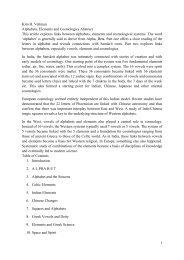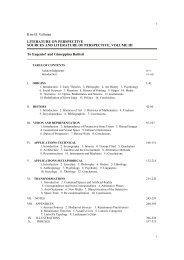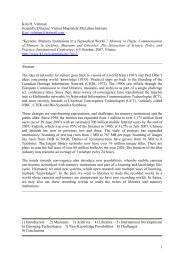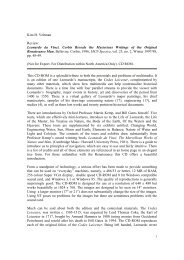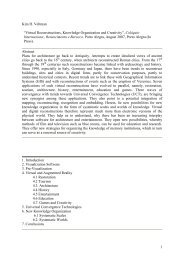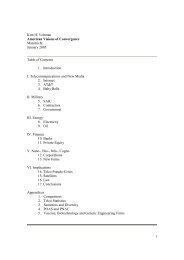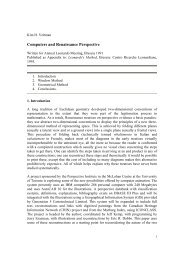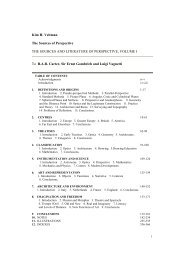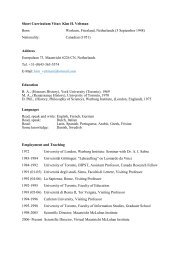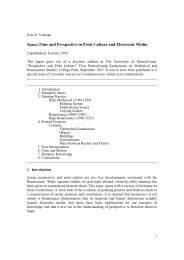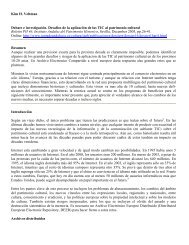1986 Perspective, Anamorphosis And Vision
1986 Perspective, Anamorphosis And Vision
1986 Perspective, Anamorphosis And Vision
You also want an ePaper? Increase the reach of your titles
YUMPU automatically turns print PDFs into web optimized ePapers that Google loves.
In 1824, William Wollaston writing “On the Apparent Direction of Eyes in a Portrait”,<br />
drew attention to the way in which eyes in a portrait follow one even if one views it from<br />
the side. 2 In 1828, the Frenchman, Raymond, also addressed this phenomenon, attempting<br />
to identify its causes. 3 Giuseppe Ovio, Director of the Institute of Clinical Ophthalmology<br />
at Modena had different motives for examining this problem of viewpoints in paintings.<br />
Convinced that the laws of linear perspective must correspond generally with those of<br />
optics, he made a series of experiments on perceptual effects produced by vertically and<br />
laterally displaced picture planes. 4 His work has not received the attention it deserves. In<br />
1931, a psychologist, Robert H. Thouless, studied how objects continue to look right even<br />
when they are seen obliquely from off side. He coined this „Phenomenal Regression to<br />
the Real Object". 5<br />
The relationship between laws of optics and linear perspective was also a starting point of<br />
Maurice Pirenne's studies. Scholars such as Panofsky (1927) 6 and White (1949, 1951) 7 had<br />
argued that linear perspective was merely a convention, at variance with optical laws.<br />
Pirenne set out to demonstrate experimentally that linear perspective had scientific laws<br />
in accordance with those of optics (1952). 8 These studies led him to compare effects of<br />
Optics, Painting and Photography (1970). 9 With a pinhole camera he painstakingly<br />
explored and analysed distortion effects with lateral displacement of three-dimensional<br />
and painted objects, including the famous trompe l'oeil ceiling in Il Gésu. In 1975 he<br />
examined what happens to a pinhole image of Piero della Francesca's Flagellation as the<br />
viewpoint is moved from in front to off side 10 ; a commentary as it were on his friend<br />
B.A.R. Carter's earlier perspectival analysis of the same picture (1953). 11 Pirenne's<br />
excellent work deserves much more study.<br />
In the meantime, however, the opinions of a philosopher with no understanding of the<br />
technicalities of perspective, attracted much more attention. Nelson Goodman (1968) felt<br />
linear perspective was a convention and insisted that an „artist who wants to produce a<br />
spatial representation that the present day Western eye will accept as faithful must defy<br />
the laws of geometry". 12 This was a direct challenge to Gibson (1960) 13 , whose response<br />
came in the form of a new definition of pictures (1971). 14<br />
In London, Ernst Gombrich had also become interested in these problems. In his essay in<br />
honour of Nelson Goodman (1972) 15 he referred to the experiment by Thouless and drew<br />
attention to constancies involved when perspectival drawings or photographs are viewed<br />
from positions off to the side. The following year, Gombrich (1973) also explored these<br />
constancies in the case of photographs of Hobbema's Avenue. 16 This confirmed that like<br />
the eyes studied by Wheatstone, painted streets also follow a viewer as he moves off to<br />
the side. These writings of Gibson, Goodman, Gombrich and Pirenne were sources for<br />
Kenneth R. Adams „<strong>Perspective</strong> and the Viewpoint" (1972) in which he analysed<br />
mathematically how geometrical picture space changes with the observer's viewpoint. 17<br />
Considered together, it is striking that these authors have all concentrated on a negative<br />
point: namely, that paintings in linear perspective when seen from viewpoints off to the<br />
side are not as distorted as one would expect. By contrast, the essay that follows will<br />
focus on a positive claim 18 : that paintings in linear perspective acquire new meaning when<br />
seen from viewpoints off to the side.<br />
3



